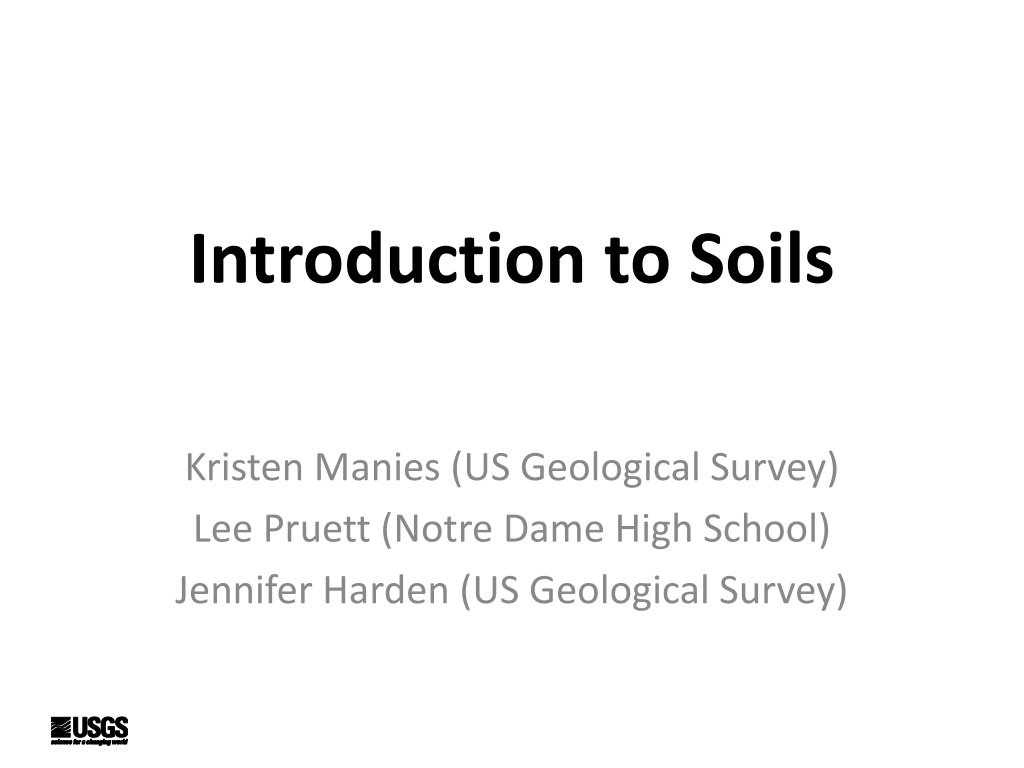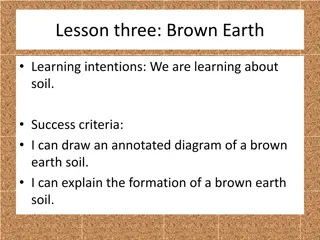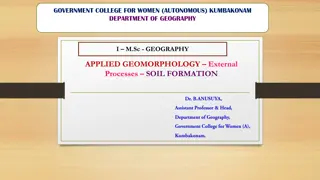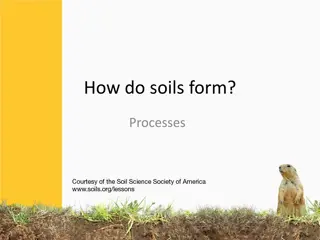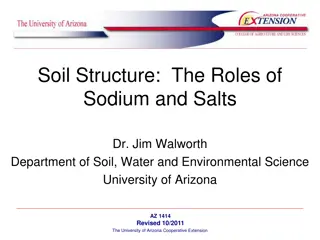Understanding the Dynamics of Soil: Formation, Properties, and Influences
Soil, the foundation of life on Earth, is a complex system influenced by various factors such as utilitarian, ecological, and pedologic processes. This introduction covers the definition of soil, its importance in agriculture and ecosystems, the formation processes, services provided by soils, threats they face, their dynamic nature over time, and how they are shaped by environmental factors.
Download Presentation

Please find below an Image/Link to download the presentation.
The content on the website is provided AS IS for your information and personal use only. It may not be sold, licensed, or shared on other websites without obtaining consent from the author. Download presentation by click this link. If you encounter any issues during the download, it is possible that the publisher has removed the file from their server.
E N D
Presentation Transcript
Introduction to Soils Kristen Manies (US Geological Survey) Lee Pruett (Notre Dame High School) Jennifer Harden (US Geological Survey)
What is soil? Often defined one of several ways: Utilitarian Ecological Pedologic
Utilitarian defined by the properties important to agriculture, engineering, etc. (soil material)
Ecological medium capable of supporting plants both physically and through the transfer of water and nutrients (soil medium)
Pedologic Formation of soil by processes such as weathering, organic matter accumulation ,and leaching (soil as a system)
Processes that Form Soils and Influence Soil Properties The movement of water down through the soil profile (leaching) Organic matter accumulation (sequesters carbon) Mineral weathering Mineral formation Many Others
Services by the Soil System Food Fiber Filtration of gas & water Water storage Carbon Storage
Threats to Soils Include: Erosion Contamination Sealing Compaction Loss of biodiversity Salinization Floods and Landslides
Soils are dynamic, they change over time Time Parent material Young soil Mature soil Old soil
As soils age, they form distinct soil horizons and a soil profile topsoil subsoil parent material
Ultimately, soils are influenced by their environment Relief Climate Organisms Humans Bacteria Parent material Fungi Vegetation
If you add time, then you get the soil forming factors: CLORPT Climate Organisms Relief Parent material Time
The Role of Climate The balance between moisture and temperature is particularly important to the development of soils. MOISTURE how much when TEMPERATURE season length range of highs/lows
Houston, TX 90 8 Temperature 80 7 Rainfall 70 6 Precipitation (in.) Temperature ( F) 60 5 50 4 40 3 Period of high rainfall also has high temperature 30 2 20 1 10 0 0
High rainfall during warm temperatures Water used by plants Lots of plant growth Darker topsoil Houston soil
Gainsville, AL 90 7 80 6 70 Precipitation (in.) Temperature ( F) 5 60 4 50 40 3 30 2 Period of high rainfall during lower temperatures Temperature 20 1 Rainfall 10 0 0
High rainfall during cooler temperatures Few plants to use water Excess water leaches through the soil Red/orange subsoil Bama soil
Low rainfall Little vegetation Little water reaches subsoil Low plant growth Salts accumulate Thin, light colored topsoil White subsoil (Orovada soil from Nevada) (Casa Grande soil From Arizona)
In summary Soil profiles reflect the conditions under which they formed. Dark topsoil: lots of plant material Red subsoil: weathering and oxidation Complex subsoil: Lots of time to differentiate horizons
The Role of Parent Material Material from which soil forms: bedrock colluviam (sediments transported via gravity to the base of a slope) alluvium (loose, eroded soil) loess (windblown material) Parent material influences mineral composition and particle size of soil. (Arizona)
Particle size Smaller, finer particles (like clay) hold water and nutrients, including carbon Coarser particles don t hold water or nutrients, but they promote oxidation (Arizona)
Linking topsoil to Parent material Coarse Fine Organic matter stays in the soil Organic matter more readily decomposed Darker brown Light brown
Linking subsoil to Parent material Coarse Fine Weathering products remain in subsoil as salts Water allows weathering and chemical transport Oxidized, red and Reduced, green and grey yellow
